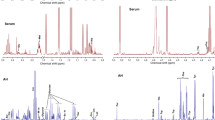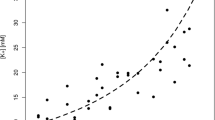Abstract
Background
Aqueous humour is the main nutritive source for corneal and lenticular tissues, and knowledge of a possible cumulative effect of ultraviolet radiation (UVR) on its metabolic profile might be of great help in the assessment of cataract risks. By using high-resolution 1H nuclear magnetic resonance (NMR) spectroscopy, it was possible to evaluate the effect of a single and repeated UVB radiation of the rabbit eye with the same overall dose on the aqueous humour.
Methods
Samples of aqueous humour from twenty-four albino white rabbit eyes were examined for the effects of UVB exposure (312 nm). In the first group (UVB1), four animals were irradiated with a single dose 3.12 J/cm2 (21 minutes) of UVB radiation. The animals in the second group (UVB2, n = 4) were irradiated three times for 7 minutes every 2nd day (dose of 1.04 J/cm2; days 1, 3, 5) to give the same overall dose (3.12 J/cm2). The third group (n = 4) served as an untreated control group. 1H NMR spectra of aqueous humour from all eyes were obtained. Special grouping patterns among the tissue samples and relative percentage changes in particular metabolite concentrations were evaluated using appropriate statistical methods (multivariate analysis, Independent sample t-test).
Results
Significant alterations in the metabolic profile of aqueous humour from UVR-B exposed rabbit eyes and an apparent cumulative effect of repeated UVB irradiation were observed.
Conclusions
Application of a Carr-Purcell-Meiboom-Gill spin echo pulse sequence was found to have a great advantage for correct analysis of the results obtained with NMR spectroscopy of aqueous humour from eyes where increase of protein level due to an inflammatory process could not be excluded.




Similar content being viewed by others
References
Ayala MN, Michael R, Söderberg PG (2000) In vivo cataract after repeated exposure to ultraviolet radiation. Exp Eye Res 70:451–456
Boettner EA, Wolter JR (1962) Transmission of the ocular media. Invest Ophthalmol 1:776–783
Čejková J, Štípek S, Crkovská J, Ardan T (2000) Changes of antioxidant enzymes in the cornea of albino rabbits irradiated with UVB rays. Histochemical and biochemical study. Histol Histopathol 15:1043–1050
Čejková J, Štípek S, Crkovská J, Ardan T, Pláteník J, Čejka C, Midelfart A (2004) UV Rays, the prooxidant/antioxidant imbalance in the cornea and oxidative eye damage. Physiol Res 53:1–10
Cullen AP (1980) Additive effects of ultraviolet radiation. Am J Optom Physiol Opt 57:808–814
De Berardinis E, Tiery O, Polzella A, Iuglio N (1965) The chemical composition of the human aqueous humour in normal and pathological conditions. Exp Eye Res 4:179–186
Fowler J, Cohen L, Jarvis P (1998) Practical Statistics for Field Biology. John Wiley & Sons Ltd, Chichester
Fris M, Tessem MB, Čejková J, Midelfart A (2006a) The effect of single and repeated UVB radiation on the rabbit cornea. Graefes Arch Clin Exp Ophthalmol 244:1680–1687
Fris M, Tessem MB, Sæther O, Midelfart A (2006b) Biochemical changes in selenite cataract model measured by high-resolution MAS 1H NMR spectroscopy. Acta Ophthalmol Scand 84:684–692
Gabelt BT, Kaufman PL (2002) Aqueous humor hydrodynamics. In: Hart WM (ed) Adler’s physiology of the eye: clinical application, 10th edn. Mosby, St Louis, pp 237–289
Goralska M, Holley BL, McGahan MC (2001) Overexpression of H- and L-ferritin subunits in lens epithelial cells: Fe metabolism and cellular response to UVB irradiation. Invest Ophthalmol Vis Sci 42:1721–1727
Govindaraju V, Young K, Maudsley AA (2000) Proton NMR chemical shifts and coupling constants for brain metabolites. NMR Biomed 13:129–153
Gribbestad IS, Midelfart A (1994) High-resolution 1H NMR spectroscopy of aqueous humour from rabbits. Graefes Arch Clin Exp Ophthalmol 232:494–498
Hightower KR, Reddan JR, McCready JP, Dziedzic DC (1994) Lens epithelium: a primary target of UVB irradiation. Exp Eye Res 59:557–564
Ishimoto S, Wu GS, Hayashi S, Zhang J, Rao NA (1996) Free radical tissue damages in the anterior segment of the eye in experimental autoimmune uveitis. Invest Ophthalmol Vis Sci 37:630–636
Kilic F, Bhardwaj R, Caulfeild J, Trevithick JR (1999) Modelling cortical cataractogenesis 22: is in vitro reduction of damage in model diabetic rat cataract by taurine due to its antioxidant activity? Exp Eye Res 69:291–300
Kriat M, Confort-Gouny S, Vion-Dury J, Sciaky M, Viout P, Cozzone PJ (1992) Quantitation of metabolites in human blood serum by proton magnetic resonance spectroscopy. A comparative study of the use of formate and TSP as concentration standards. NMR Biomed 5:179–184
Lattimor MR Jr (1989) Effect of ultraviolet radiation on the energy metabolism of the corneal epithelium of the rabbit. Photochem Photobiol 49:175–180
Lodovici M, Raimondi L, Guglielmi F, Gemignani S, Dolara P (2003) Protection against ultraviolet B-induced oxidative DNA damage in rabbit corneal-derived cells (SIRC) by 4-coumaric acid. Toxicology 184:141–147
Lou MF (2003) Redox regulation in the lens. Prog Retin Eye Res 22:657–682
Löfgren S, Söderberg PG (2001) Lens lactate dehydrogenase inactivation after UV-B irradiation: an in vivo measure of UVR-B penetration. Invest Ophthalmol Vis Sci 42:1833–1836
Manzer R, Pappa A, Estey T, Sladek N, Carpenter F, Vasiliou V (2003) Ultraviolet radiation decreases expression and induces aggregation of corneal ALDH3A1. Chemico-Biol Interactions 143–144:45–53
Meiboom S, Gill D (1958) Modified spin-echo method for measuring nuclear relaxation times. Rev Sci Instrum 29:688–691
Michael R, Brismar H (2001) Lens growth and protein density in the rat lens after in vivo exposure to ultraviolet radiation. Invest Ophthalmol Vis Sci 42:402–408
Midelfart A (2005) Ultraviolet radiation and cataract. Acta Ophthalmol Scand 83:642–644
Peyman GA, Fishman PH, Alexander KR, Woodhouse M, Weinreb RN (1986) The effect of ultraviolet, visible and infrared radiation on the rabbit blood-aqueous barrier. Exp Eye Res 42:249–254
Pitts DG, Cullen AP, Hacker PD (1977) Ocular effects of ultraviolet radiation from 295 to 365 nm. Invest Ophthalmol Vis Sci 16:932–939
Reddy VN, Giblin FJ, Lin LR, Chakrapani B (1998) The effect of aqueous humor ascorbate on ultraviolet-B-induced DNA damage in lens epithelium. Invest Ophthalmol Vis Sci 39:344–350
Ringvold A (1996) The significance of ascorbate in the aqueous humour protection against UV-A and UV-B. Exp Eye Res 62:261–264
Ringvold A (1997) In vitro evidence for UV-protection of the eye by the corneal epithelium mediated by the cytoplasminc protein, RNA, and ascorbate. Acta Ophthalmol Scand 75:496–498
Ringvold A (1998) Corneal epithelium and UV-protection of the eye. Acta Ophthalmol Scand 76:149–153
Risa Ø, Sæther O, Löfgren S, Søderberg PG, Krane J, Midelfart A (2004) Metabolic changes in rat lens after in vivo exposure to ultraviolet irradiation: measurements by high resolution MAS 1H NMR spectroscopy. Invest Ophthalmol Vis Sci 45:1916–1921
Risa Ø, Saether O, Kakar M, Mody V, Löfgren S, Soderberg PG, Krane J, Midelfart A (2005) Time dependency of metabolic changes in rat lens after in vivo UVB irradiation analysed by HR-MAS (1)H NMR spectroscopy. Exp Eye Res 81:407–414
Rose RC, Bode AM (1991) Ocular ascorbate transport and metabolism. Comp Biochem Physiol A 100:273–285
Roy B, Ghosh SK (1991) Purification and properties of the low-molecular-weight alpha-crystallin from normal goat lens: comparison with bovine lens. Exp Eye Res 53:693–701
Söderberg PG, Löfgren S, Ayala M, Dong X, Kakar M, Mody V (2002) Toxicity of ultraviolet radiation exposure to the lens expressed by maximum tolerable dose. Dev Ophthalmol 35:70–75
Söderberg PG, Michael R, Merriam JC (2003) Maximum acceptable dose of ultraviolet radiation: a safety limit for cataract. Acta Ophthalmol Scand 81:165–169
Stevens JJ, Rogers C, Howard CB, Moore C, Chan LM (2005) Analysis of gene regulation in rabbit corneal epithelial cells induced by ultraviolet radiation. Int J Environ Res Public Health 2:51–57
Sæther O, Risa Ø, Čejková J, Krane J, Midelfart A (2004) High-resolution magic angle spinning 1H NMR spectroscopy of metabolic changes in rabbit lens after treatment with dexamethasone combined with UVB exposure. Graefes Arch Clin Exp Ophthalmol 242:1000–1007
Sæther O, Krane J, Risa Ø, Čejková J, Midelfart A (2005) High-resolution MAS 1H NMR spectroscopic analysis of rabbit cornea after treatment with dexamethasone and exposure to UVB radiation. Curr Eye Res 30:1041–1049
Tessem MB, Bathen TF, Čejková J, Midelfart A (2005) Effect of UV-A and UV-B irradiation on the metabolic profile of aqueous humor in rabbits analysed by 1H NMR spectroscopy. Invest Ophthalmol Vis Sci 46:776–781
Tessem MB, Bathen FT, Čejková J, Midelfart A (2006) Effect of UV-A and UV-B irradiation on the metabolic profile of rabbit cornea and lens analysed by HR-MAS 1H NMR spectroscopy. Ophthalmic Res 38:105–114
Tong L, Corrales RM, Chen Z, Villarreal AL, De Paiva CS, Beuerman R, Li DQ, Pflugfelder SC (2006) Expression and regulation of cornified envelope proteins in human corneal epithelium. Invest Ophthalmol Vis Sci 47:1938–1946
Willker W, Engelmann J, Brand A, Liebfritz D (1996) Metabolite identification in cell extracts and culture media by proton-detected 2D-H,C-NMR spectroscopy. J Magn Reson Anal 2:21–32
Acknowledgements
This study was supported by The Norwegian Quota Program, grants from the Faculty of Medicine, Norwegian University of Science and Technology, a grant from The Norwegian Research Council, a Grant from the Grant Agency of the Czech Republic No. 304/06/1379 and a Grant from the Academy of Sciences of the Czech Republic AVOZ50390512.
Author information
Authors and Affiliations
Corresponding author
Additional information
Grants were received from:
The Norwegian Quota Program
The Faculty of Medicine, Norwegian University of Science and Technology
The Norwegian Research Council
The Grant Agency of the Czech Republic No. 304/06/1379
The Academy of Sciences of the Czech Republic AVOZ50390512.
Rights and permissions
About this article
Cite this article
Fris, M., Čejková, J. & Midelfart, A. Changes in aqueous humour following single or repeated UVB irradiation of rabbit cornea. Graefes Arch Clin Exp Ophthalmol 245, 1705–1711 (2007). https://doi.org/10.1007/s00417-007-0620-7
Received:
Revised:
Accepted:
Published:
Issue Date:
DOI: https://doi.org/10.1007/s00417-007-0620-7




